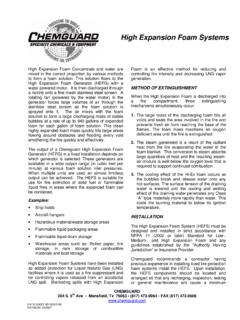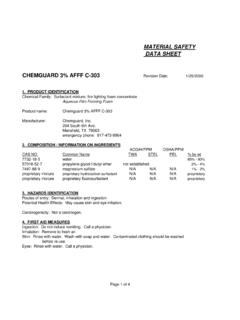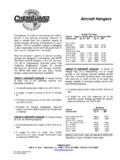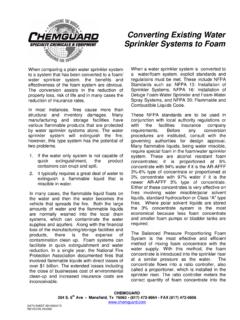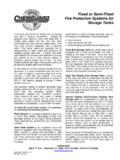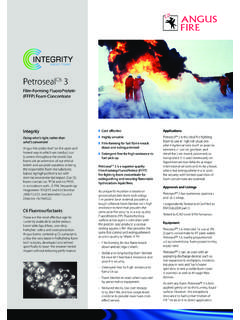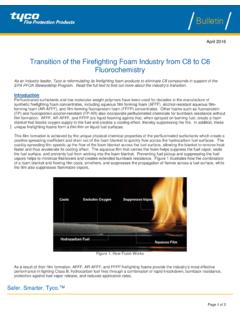Transcription of 01 General Foam Information - chemguard.com
1 CHEMGUARD 204 S. 6th Ave Mansfield, Tx 76063 (817) 473-9964 FAX (817) 473-0606 DATA SHEET #D10D03010 REVISION: 09/2005 For years, foam has been used as a fire-extinguishing medium for flammable and combustible liquids. Unlike other extinguishing agents - water, dry chemical, CO2, etc., a stable aqueous foam can extinguish a flammable or combustible liquid fire by the combined mechanisms of cooling, separating the flame/ignition source from the product surface, suppressing vapors and smothering.
2 It can also secure for extended periods of time against re-flash or reignition. Water, if used on a standard hydrocarbon fuel, is heavier than most of those liquids and if applied directly to the fuel surface, will sink to the bottom having little or no effect on extinguishment or vapor suppression. If the liquid fuel heats above 212 F, the water may boil below the fuel surface throwing the fuel out of the contained area and spreading the fire.
3 For this reason, foam is the primary fire-extinguishing agent for all potential hazards or areas where flammable liquids are transported, processed, stored or used as an energy source. Before reviewing the merits of the different types of foam concentrates, there are certain terminologies associated with foam that must be understood. FOAM: A fire fighting foam is simply a stable mass of small air-filled bubbles, which have a lower density than oil, gasoline or water.
4 Foam is made up of three ingredients - water, foam concentrate and air. When mixed in the correct proportions, these three ingredients form a homogeneous foam blanket. FOAM SOLUTION: This is a solution of water and foam concentrate after they have been mixed together in the correct proportions. FOAM CONCENTRATE: This liquid concentrate is supplied from the manufacturer which when mixed with water in the correct proportion forms a foam solution.
5 FINISHED FOAM: Foam solution as it exits a discharge device, having been aerated. DRAINAGE RATE: This is the rate at which the foam solution will drain from the expanded foam mass or how long it will take for 25% of the solution to drain from the foam. This is often called the quarter life or 25% drain time. Foam that has a fast drain time is normally very fluid and mobile, spreading across the fuel surface very quickly. While foams with longer drain times are normally less mobile, they move across the fuel surface slowly.
6 EXPANSION RATE: Volume of finished foam divided by the volume of foam solution used to create the finished foam; , a ratio of 5 to 1 would mean that one gallon of foam solution after aeration would fill an empty 5-gallon container with the expanded foam mass. LOW EXPANSION FOAM: Foam aerated to an expansion ratio of between 2 to 1 and 20 to 1. MEDIUM EXPANSION FOAM: Expansion ratio between 20 to 1 and 200 to 1. HIGH EXPANSION FOAM: Expansion ratio above 200 to 1.
7 MIXING RATE: (Correct amount of foam concentrate to be mixed with water): The amount is normally shown on the pail or drum of concentrate. The container will normally display a figure or combination of figures. Normal figures shown are 1%, 2%, 3% or 6% or a combination of 1% and 3%, 3% and 3%, or 3% and 6%. If the container of foam concentrate has 3% shown, it means that for every 100 gallons of foam solution required, 3 gallons of the foam concentrate must be used in the solution with the balance being 97 gallons of water.
8 General Foam InformationCHEMGUARD 204 S. 6th Ave Mansfield, Tx 76063 (817) 473-9964 FAX (817) 473-0606 DATA SHEET #D10D03010 REVISION: 09/2005 If 6% were displayed, this would mean that 6 gallons of the foam concentrate would be required to be mixed with 94 gallons of water to form the 100 gallons of foam solution. From the above, it becomes obvious that a 3% foam concentrate is twice as concentrated as a 6% foam concentrate.
9 On the same size and type of flammable liquid fire, half as much 3% foam concentrate would be required than if the 6% foam concentrate had been used. SEAWATER COMPATABLE Can foam concentrates be used with seawater as well as fresh water? Modern day foam concentrates can be used successfully with either sea, fresh or brackish water. HOW FOAM EXTINGUISHES A FLAMMABLE LIQUID FIRE: Fire burns because there are four elements present.
10 These elements are heat, fuel, air (oxygen) and a chemical chain reaction. Under normal circumstances if any one of the elements is removed/interfered with, the fire is extinguished. Fire fighting foam does not interfere in the chemical reaction. Foam works in the following ways: The foam blankets the fuel surface smothering the fire. The foam blanket separates the flames/ignition source from the fuel surface.

